|
|
Post by exporider on Jun 11, 2018 11:39:10 GMT -8
"6,480 per hour per direction (540 per train * 12 trains per hour = 6,480)... That's not going to be nearly enough during crush time." Based on what? 30 percent mode share? That's not realistic. Current travel through the Sepulveda Pass is ~15,000 people peak direction trips per hour during the peak periods. If that volume increases to 20,000, the LRT capacity that you calculated would be enough to serve 32% on the travel demand. Based on induced demand + a very high mode share. If there were no traffic on the 405 during peak hours you'd see way more than 15,000 people per hour. Plus, with the car congestion on this corridor, I don't think 30% is that unrealistic, especially considering the fact that this will be a heavy rail line (fast) connecting to a completed Purple line (fast) and the expo line on one end, and an improved orange line and a new east San Fernando valley light rail line on the other end. The transit connectivity here will be beyond anything we see in LA today outside of DTLA. A 30 percent transit mode share is outrageously unrealistic for this corridor! What most people fail to consider is that the vast majority of travelers through the Sepulveda Pass would have to transfer (or park-and-ride) at least twice to make the same trip using the proposed rail service. Consider: - ~1 percent of Sepulveda Pass travelers (~5,000 people per day) could make a one seat ride (i.e. they're within walking distance of train stations on both sides of the pass). Assume 80 percent transit mode share for these people: ~4,000 daily riders. - ~10 percent of Sepulveda Pass travelers (~50,000 people per day) could make a two-seat ride (i.e. either park-and-ride or transit at one end, and walk at the other end). Assume 40 percent transit mode share for these people: ~20,000 daily riders. - Remaining (~89 percent) of Sepulveda Pass travelers (~450,000 people per day) would have to make at least a three-seat ride (i.e. either park-and-ride or transit on both sides of the pass). Assume 10 percent transit mode share for these people: ~45,000 daily riders. - Total: ~70,000 daily riders, or 14 percent of the "induced" demand. Note that all of these mode shares are outrageously high for people who are used to having a single seat ride in their car. You can play with these numbers to create a scenario that shows an increased demand, possibly as high as 100,000 daily trips, but nowhere close to 30 percent mode share. |
|
expo
Junior Member
 
Posts: 71 
|
Post by expo on Jun 11, 2018 14:06:00 GMT -8
Based on induced demand + a very high mode share. If there were no traffic on the 405 during peak hours you'd see way more than 15,000 people per hour. Plus, with the car congestion on this corridor, I don't think 30% is that unrealistic, especially considering the fact that this will be a heavy rail line (fast) connecting to a completed Purple line (fast) and the expo line on one end, and an improved orange line and a new east San Fernando valley light rail line on the other end. The transit connectivity here will be beyond anything we see in LA today outside of DTLA. A 30 percent transit mode share is outrageously unrealistic for this corridor! What most people fail to consider is that the vast majority of travelers through the Sepulveda Pass would have to transfer (or park-and-ride) at least twice to make the same trip using the proposed rail service. Consider: - ~1 percent of Sepulveda Pass travelers (~5,000 people per day) could make a one seat ride (i.e. they're within walking distance of train stations on both sides of the pass). Assume 80 percent transit mode share for these people: ~4,000 daily riders. - ~10 percent of Sepulveda Pass travelers (~50,000 people per day) could make a two-seat ride (i.e. either park-and-ride or transit at one end, and walk at the other end). Assume 40 percent transit mode share for these people: ~20,000 daily riders. - Remaining (~89 percent) of Sepulveda Pass travelers (~450,000 people per day) would have to make at least a three-seat ride (i.e. either park-and-ride or transit on both sides of the pass). Assume 10 percent transit mode share for these people: ~45,000 daily riders. - Total: ~70,000 daily riders, or 14 percent of the "induced" demand. Note that all of these mode shares are outrageously high for people who are used to having a single seat ride in their car. You can play with these numbers to create a scenario that shows an increased demand, possibly as high as 100,000 daily trips, but nowhere close to 30 percent mode share. Your math would suggest this line, even as a completely grade separated heavy rail line, would have ridership similar to the Expo Line, a slow line with a significant number of non-gated (and non preemption) grade crossings. Also, the best comp is probably the Red Line, which is the only other line to stretch from the basin to the valley. As recently as 2016 it had 150k boardings per day. Understood that it hits greater density neighborhoods (Hollywood, Downtown), but again your math would suggest this line would have less than half the ridership than the Red Line. I think that is a dramatic underestimate of the demand in this corridor. |
|
|
|
Post by exporider on Jun 11, 2018 21:39:16 GMT -8
expo:
My math describes ridership at the peak load point, not total ridership on the route. The peak load point for Expo is ~30,000 two-way passengers per day. So the ridership demand that I'm describing for Sepulveda would have a peak load of ~140,000 two-way passengers per day, more than four times the peak loads on Expo.
The peak load point of the Red Line carries 50-55,000 two-way passengers per day, but that's between 7th/Metro and Vermont/Sunset. Through the tunnel to North Hollywood the transit load is less than 40,000 passengers per day.
You're telling me that you think the Sepulveda Corridor will have a peak load of over 200,000 passengers per day, more than five times the peak load between North Hollywood and Hollywood.
Two rail lines from the SF Valley to the LA basin - one line to densely developed Hollywood and DTLA, and the other to the westside, where most neighborhood refuse to approve any development over four stories. Which one do you think will attract higher ridership?
LRT provides more than enough capacity to serve the Sepulveda Pass corridor.
|
|
|
|
Post by bzcat on Jun 12, 2018 11:52:38 GMT -8
LRT may be enough if you assume development patterns are locked in.
We may regret that decision if either the Valley or the West side get up zoned in the future.
That being said, there are a lot of things Metro can do to increase capacity of LRT to that of HRT. In North America, the term has a size distinction but outside North America, the term generally refers to the conduction technology: overhead catenary vs. 3rd rail. There are many examples overseas of "light rail" metros that carry higher capacity than the Red/Purple line in LA.
|
|
|
|
Post by North Valley on Jun 12, 2018 14:15:48 GMT -8
As bzcat suggests if the Valley or the Westside gets upsized then things could get dicey. There is already some evidence that Woodland Hills will be getting lots more residents because of the on going redevelopment of Warner Center and the closure and redevelopment of the site along Victory Blvd where the space shuttle engines were manufactured. This in particular is why I like the Branched service option.
On a bit of a tangent, LA needs to build a hell of lot more apartments, condos, etc. and the reckoning is probably going to start on major streets near mass transit stops when/if the public allows the politicians to do that. Which might be never or sometime in the next 20 years.
|
|
|
|
Post by culvercitylocke on Jun 13, 2018 8:48:41 GMT -8
I made a simple version of what the LA metro would look like if we were to extend the Purple Line to LAX, the purple line would literally have a connection to every single LRT in the city. 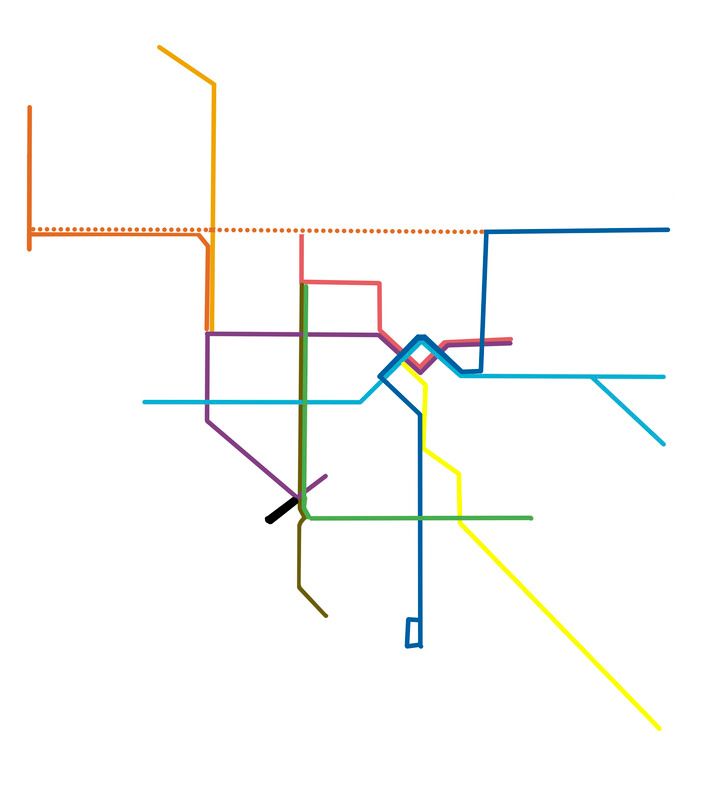 |
|
|
|
Post by bzcat on Jun 13, 2018 11:07:57 GMT -8
That's actually not a terrible idea... just extend the Purple line south instead of a 3 way junction with north and south spur at VA station.
|
|
|
|
Post by metrocenter on Jun 13, 2018 11:23:36 GMT -8
My ideal concept: HRT with a wye at Westwood Station. The northern branch would head north to the SF Valley, with a stop at UCLA. The western branch would continue to the VA and then head south.
|
|
|
|
Post by culvercitylocke on Jun 13, 2018 12:47:09 GMT -8
That's actually not a terrible idea... just extend the Purple line south instead of a 3 way junction with north and south spur at VA station. And if the purple line were to use centinela as a corridor (best way to hit the silicon plex at east playa vista as well as Howard Hughes ) it also more or less neutralizes the need for rail on Lincoln, which would necessitate near impossible construction near or under lax at the south end of such a line. |
|
|
|
Post by culvercitylocke on Jun 13, 2018 13:15:45 GMT -8
In terms of how metro will think about a centinela or sepulveda route to lax, consider this map from the WSAB and note how option G route is designed to maximize coverage of the circles to south downtown  Those are half mile circles around stations, and they help to indicate the land area covered by a transit stop. The 405 is about 350 to 500 feet wide next to sepulveda, and for 3.5 miles from Santa Monica Blvd to Culver blvd, sepulveda is only about 175 feet east of the 405. That means that a rather large area of each stations circle will be consumed by the 405. That’s going to hurt its performance scores. Additionally, with new politics arising that will prevent construction of housing near freeways, the possibility of new TOD is likely to be much less. Inglewood would possibly be better from a density POV, but that would require curving back to Inglewood after a stop at Venice centinela because Inglewood only makes sense south of Venice. But then centinela/Jefferson is clearly superior stop so you’d have to curve back to centinela for that one. |
|
|
|
Post by North Valley on Jun 15, 2018 18:25:07 GMT -8
|
|
|
|
Post by culvercitylocke on Jun 17, 2018 14:02:36 GMT -8
Not a surprise, but it means that the three options going to Sepulveda Blvd instead of Van Nuys blvd can now be officially eliminated, because now they are obsolete trash. |
|
|
|
Post by bzcat on Jun 18, 2018 14:33:49 GMT -8
In terms of how metro will think about a centinela or sepulveda route to lax, consider this map from the WSAB and note how option G route is designed to maximize coverage of the circles to south downtown Those are half mile circles around stations, and they help to indicate the land area covered by a transit stop. The 405 is about 350 to 500 feet wide next to sepulveda, and for 3.5 miles from Santa Monica Blvd to Culver blvd, sepulveda is only about 175 feet east of the 405. That means that a rather large area of each stations circle will be consumed by the 405. That’s going to hurt its performance scores. Additionally, with new politics arising that will prevent construction of housing near freeways, the possibility of new TOD is likely to be much less. Inglewood would possibly be better from a density POV, but that would require curving back to Inglewood after a stop at Venice centinela because Inglewood only makes sense south of Venice. But then centinela/Jefferson is clearly superior stop so you’d have to curve back to centinela for that one. That's why on these boards many years ago, I advocated for Westwood/Overland alignment rather than following Sepulveda/405 to Culver City. Westwood/Overland alignment: 1. Westwood/Wilshire 2. Westwood/Santa Monica 3. Westwood/Expo line (or Westwood/Pico midblock between Expo and Pico with connections to both Expo station and Pico Blvd) 4. Overland/Venice (Sony Studios) 5. Overland/Jefferson (West LA College) 6. Fox Hills Mall transit center 7. Sepulveda/Manchester 8. 98th street/Aviation LAX transit center Sepulveda alignment: 1. Westwood/Wilshire 2. Sepulveda/Santa Monica 3. Sepulveda/Expo line (Pico) 4. Sepulveda/Venice 5. Sepulveda/Culver (optional) 6. Fox Hills Mall transit center 7. Sepulveda/Manchester 8. 98th street/Aviation LAX transit center Both alignment are basically the same length. Stations 1-5 are different but Westwood/Overland hits more job centers and residential density. Stations 6-8 are the same. But I sort of like your Bundy/Centinela alignment too Bundy/Centinela alignment:1. VA Hospital 2. Wilshire/Bundy 3. Bundy/Olympic (Expo line) 4. Centinela/Venice 5. Centinela/Jefferson (Playa Vista) 6. Fox Hills Mall transit center 7. Sepulveda/Manchester 8. 98th street/Aviation LAX transit center Again, Stations 1-5 are different and we can extend the purple line to Wilshire/Bundy which in itself is not a bad idea. Station 6-8 are the same again. |
|
|
|
Post by culvercitylocke on Jun 18, 2018 16:28:54 GMT -8
In terms of how metro will think about a centinela or sepulveda route to lax, consider this map from the WSAB and note how option G route is designed to maximize coverage of the circles to south downtown Those are half mile circles around stations, and they help to indicate the land area covered by a transit stop. The 405 is about 350 to 500 feet wide next to sepulveda, and for 3.5 miles from Santa Monica Blvd to Culver blvd, sepulveda is only about 175 feet east of the 405. That means that a rather large area of each stations circle will be consumed by the 405. That’s going to hurt its performance scores. Additionally, with new politics arising that will prevent construction of housing near freeways, the possibility of new TOD is likely to be much less. Inglewood would possibly be better from a density POV, but that would require curving back to Inglewood after a stop at Venice centinela because Inglewood only makes sense south of Venice. But then centinela/Jefferson is clearly superior stop so you’d have to curve back to centinela for that one. That's why on these boards many years ago, I advocated for Westwood/Overland alignment rather than following Sepulveda/405 to Culver City. Westwood/Overland alignment: 1. Westwood/Wilshire 2. Westwood/Santa Monica 3. Westwood/Expo line (or Westwood/Pico midblock between Expo and Pico with connections to both Expo station and Pico Blvd) 4. Overland/Venice (Sony Studios) 5. Overland/Jefferson (West LA College) 6. Fox Hills Mall transit center 7. Sepulveda/Manchester 8. 98th street/Aviation LAX transit center Sepulveda alignment: 1. Westwood/Wilshire 2. Sepulveda/Santa Monica 3. Sepulveda/Expo line (Pico) 4. Sepulveda/Venice 5. Sepulveda/Culver (optional) 6. Fox Hills Mall transit center 7. Sepulveda/Manchester 8. 98th street/Aviation LAX transit center Both alignment are basically the same length. Stations 1-5 are different but Westwood/Overland hits more job centers and residential density. Stations 6-8 are the same. But I sort of like your Bundy/Centinela alignment too Bundy/Centinela alignment:1. VA Hospital 2. Wilshire/Bundy 3. Bundy/Olympic (Expo line) 4. Centinela/Venice 5. Centinela/Jefferson (Playa Vista) 6. Fox Hills Mall transit center 7. Sepulveda/Manchester 8. 98th street/Aviation LAX transit center Again, Stations 1-5 are different and we can extend the purple line to Wilshire/Bundy which in itself is not a bad idea. Station 6-8 are the same again. Stations 6-8 would require a lengthy diversion that would entail crossing the 405 twice, that is probably expensive. I kind of prefer your overland route for LRt, but I am enamored with the purple line extension to lax. It seems as though metro will not be considering an overland route though because all the alternatives go to either sepulveda or Bundy, none go to overland. I think they are doing that to steer us to Bundy eventually, because they want to expand coverage to west la and more significantly, your stops 4-6 make the lines contained mostly within Culver City, and politically and demographically, Culver City probably doesn’t need a dedicated rail line. For Bundy, I think you could have a stop at culver as well, it might pencil out decent for ridership, the area near the freeway stub is full of apartments and surprisingly dense, residentially, like the area of Santa Monica within a mile west of the 405. Also the area is a hub of new residents working in playa vista, so there is ridership to be tapped that wasn’t there five years ago. |
|
|
|
Post by North Valley on Jun 19, 2018 14:02:56 GMT -8
Not a surprise, but it means that the three options going to Sepulveda Blvd instead of Van Nuys blvd can now be officially eliminated, because now they are obsolete trash. Your harsh sentiment is hilarious. Reminds me of someone........... |
|
|
|
Post by culvercitylocke on Jun 21, 2018 8:17:15 GMT -8
The Supreme Court just ruled all online retail has to collect state and local sales taxes on purchases. That is probably going to infuse some additional money into R and M
|
|
|
|
Post by usmc1401 on Jun 21, 2018 11:16:08 GMT -8
That's about $118 million plus a year for California transit
|
|
expo
Junior Member
 
Posts: 71 
|
Post by expo on Jun 21, 2018 15:19:57 GMT -8
Interested to see your math and how it translates to additional revenue for Metro specifically
|
|
|
|
Post by culvercitylocke on Jun 21, 2018 16:24:44 GMT -8
well if all ecommerce has to collect local sales tax now, then that local sales tax (the LA county taxes Measure M and R for example) will now be collected and remitted. It's not going to collect billions, but it might be enough to pay for an arts district station. or line the pockets of Phil Washington and contractors, probably the latter.  |
|
|
|
Post by bzcat on Jun 21, 2018 17:42:51 GMT -8
Stations 6-8 would require a lengthy diversion that would entail crossing the 405 twice, that is probably expensive. I kind of prefer your overland route for LRt, but I am enamored with the purple line extension to lax. It seems as though metro will not be considering an overland route though because all the alternatives go to either sepulveda or Bundy, none go to overland. I think they are doing that to steer us to Bundy eventually, because they want to expand coverage to west la and more significantly, your stops 4-6 make the lines contained mostly within Culver City, and politically and demographically, Culver City probably doesn’t need a dedicated rail line. For Bundy, I think you could have a stop at culver as well, it might pencil out decent for ridership, the area near the freeway stub is full of apartments and surprisingly dense, residentially, like the area of Santa Monica within a mile west of the 405. Also the area is a hub of new residents working in playa vista, so there is ridership to be tapped that wasn’t there five years ago. I think we agree that either Overland or Bundy is better than Sepulveda. I'm honestly ok with either one. As for Culver City getting 3 stations on the Overland alignment... two of those are on the border with City of LA (Venice, and Fox Hills) so I don't necessarily think it is a problem. If you had to eliminate a station, the one to get rid of is Overland/Jefferson. Outside of West LA College, the area is zoned for single family homes and it's unlikely that Culver City will upzone the area. It's definitely the most marginal station that I have proposed. |
|
|
|
Post by culvercitylocke on Jun 22, 2018 9:41:22 GMT -8
Stations 6-8 would require a lengthy diversion that would entail crossing the 405 twice, that is probably expensive. I kind of prefer your overland route for LRt, but I am enamored with the purple line extension to lax. It seems as though metro will not be considering an overland route though because all the alternatives go to either sepulveda or Bundy, none go to overland. I think they are doing that to steer us to Bundy eventually, because they want to expand coverage to west la and more significantly, your stops 4-6 make the lines contained mostly within Culver City, and politically and demographically, Culver City probably doesn’t need a dedicated rail line. For Bundy, I think you could have a stop at culver as well, it might pencil out decent for ridership, the area near the freeway stub is full of apartments and surprisingly dense, residentially, like the area of Santa Monica within a mile west of the 405. Also the area is a hub of new residents working in playa vista, so there is ridership to be tapped that wasn’t there five years ago. I think we agree that either Overland or Bundy is better than Sepulveda. I'm honestly ok with either one. As for Culver City getting 3 stations on the Overland alignment... two of those are on the border with City of LA (Venice, and Fox Hills) so I don't necessarily think it is a problem. If you had to eliminate a station, the one to get rid of is Overland/Jefferson. Outside of West LA College, the area is zoned for single family homes and it's unlikely that Culver City will upzone the area. It's definitely the most marginal station that I have proposed. I've done some additional reading on Barcelona Line 9&10, and I'm not so sure that crossing the 405 would be that big a deal to get your stations 6-8 here's a map of Barcelona line 9 and 10. Basically, they can route wherever, because the tunneling is deep, so one of the biggest advantages is being able to ignore the street grid. 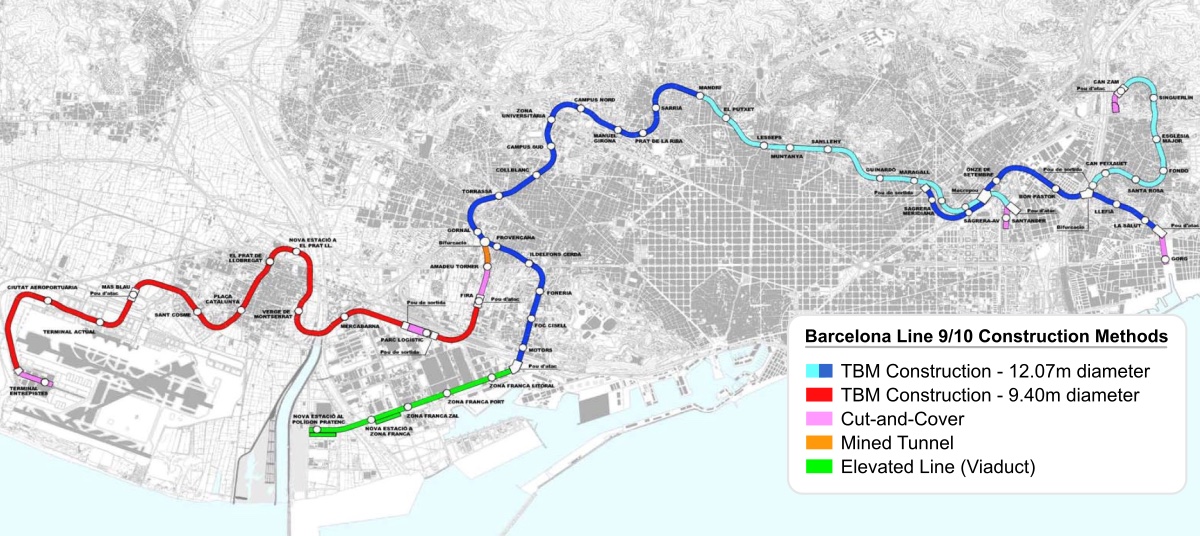 They standardized Station construction so that all the excavations are identical, basically looks like a big circle. That saves enormous time and money. 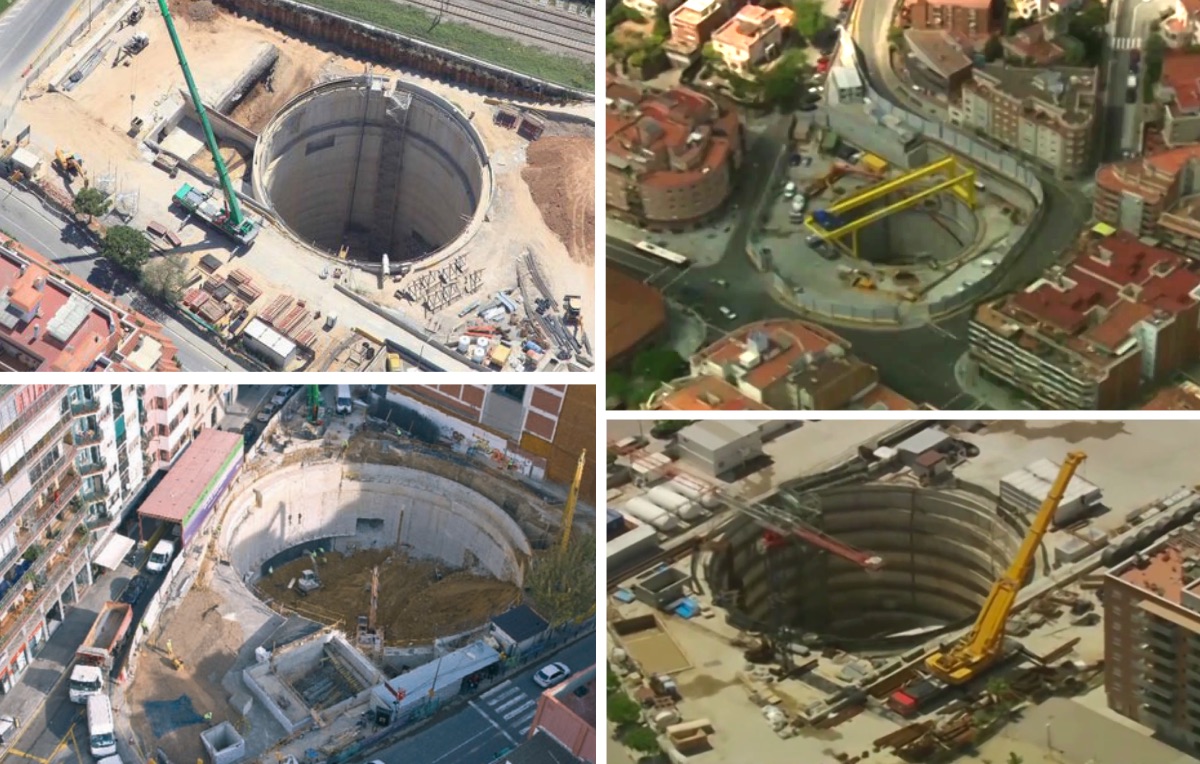 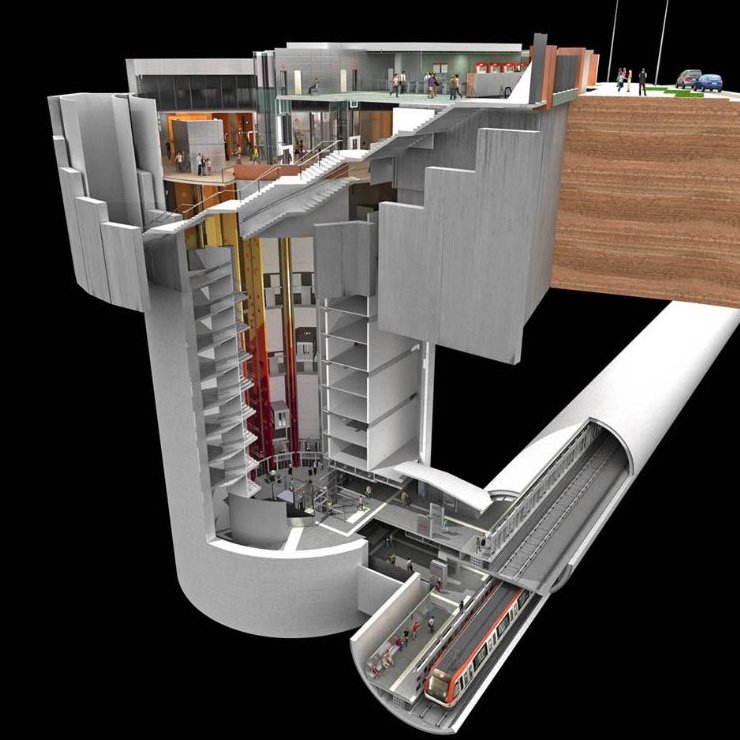 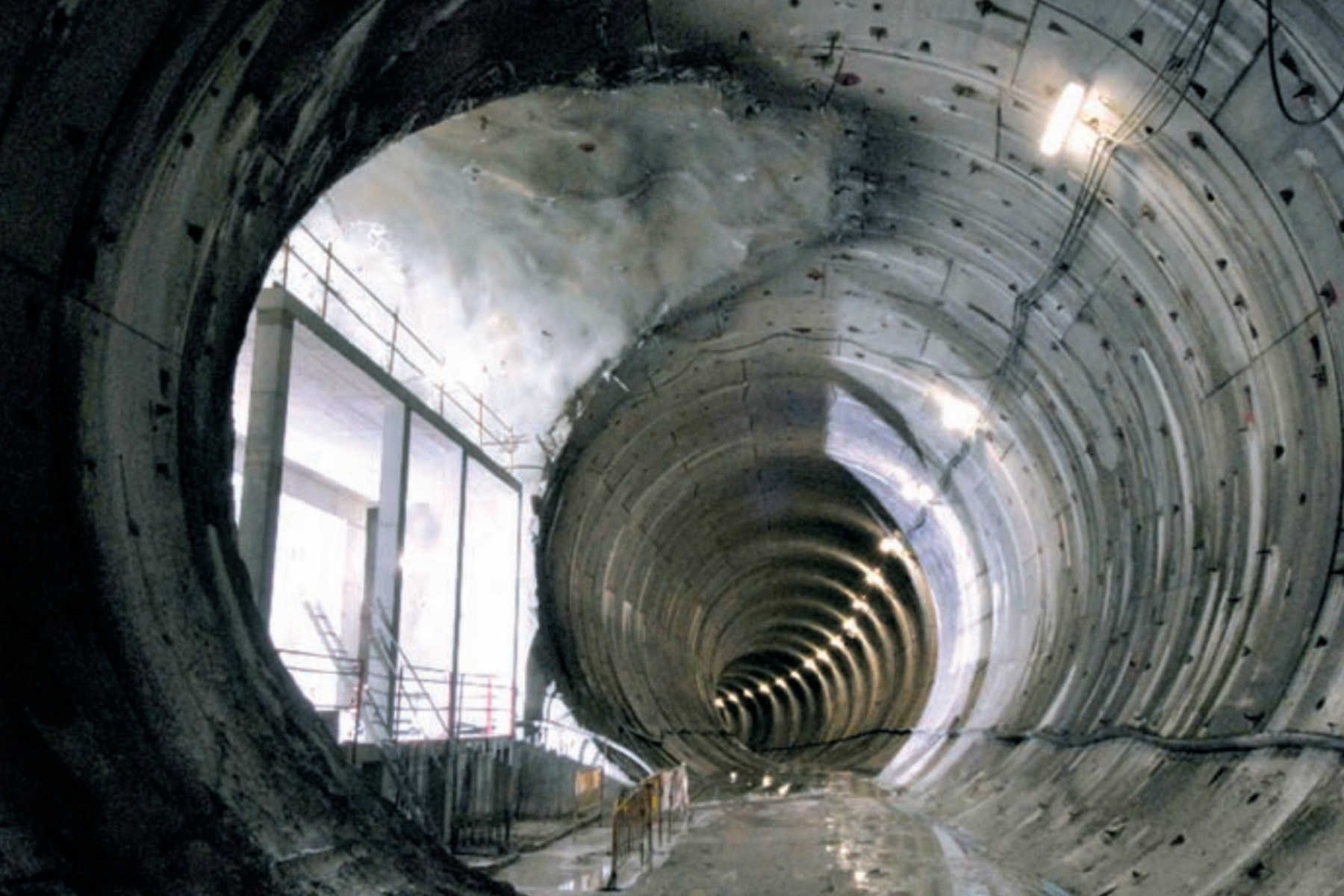 But, they seem to be running the trains in parallel most of the time between stations (to facilitate crossovers), with ramps up or down at each station location. This is a problem for safety in the USA because it affords little emergency egress opportunities because we would have to use the third rail that is used on the purple and red line. The Barcelona solution is to put the third rail on the cieling: 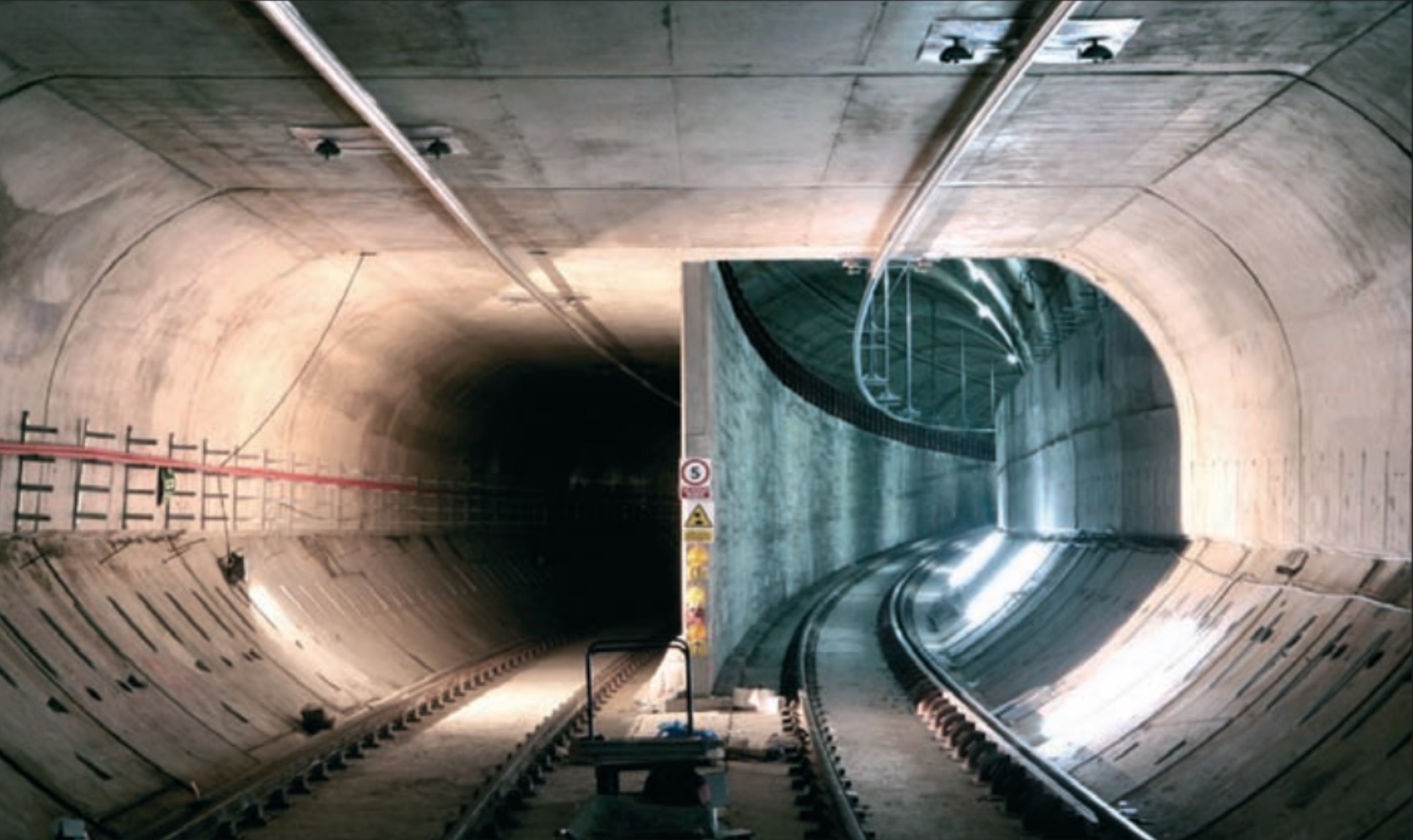 However, If metro were to use this superior and cheaper and faster construction method for a purple line extension to LAX (or the sepulveda corridor between Wilshire westwood and the orange line), they will have larger station spacing between stations, they could run the trains on two levels most of the time, with crossovers in the middle every other station. Crafting emergency pathways would probably be simpler and safer that way, and they could still use the third rail. This would probably entail a longer construction schedule and more expense, becauase you're building two road beds for most of the tunnel length (other than crossovers) whereas the barcelona tunnel has one road bed except when they split up and down for the stacked station, entering and exiting the station. But, the road bed cost would still be worth it, because one of the biggest political advantages to leverage for Single Bore is that it is safer than dual bore and does not require Cross passages to be built, which means jet grouting does not have to occur. Jet Grouting is an enormous street disrupter and a huge motivater of community opposition, because its a mutli year pain in the ass, unlike the unseen, unheard, unnoticed tunneling. here's more on line 9 www.cat-bus.com/2017/10/barcelonas-line-9-inspiring-montreals-pink-line/ |
|
|
|
Post by usmc1401 on Jun 22, 2018 15:19:28 GMT -8
Back of a napkin math. 118 billion a year in nontaxed internet sales. California 10 percent of USA population 11.8 billion on sales then one percent for transit statewide equals 118 million. Some parts of state may get more some less.
|
|
|
|
Post by culvercitylocke on Jun 27, 2018 11:57:18 GMT -8
|
|
|
|
Post by bzcat on Jun 28, 2018 9:44:04 GMT -8
Alon has some good ideas but this isn't one of them.
|
|
|
|
Post by culvercitylocke on Jun 28, 2018 17:12:00 GMT -8
Alon has some good ideas but this isn't one of them. Yeah it’s a pretty bad idea, I’m guessing most cities he studies are not bisected by a nine km wide mountain range. Also, context is important and he lacks it here, I don’t think anyone wants more construction in the 405, and bogging it down with another decade of construction after the last decade of endless construction is a pretty nasty imposition on everyone in Los Angeles. And you’d still Have to route to leave the 405 and tunnel to UCLA for at least 2.67 km. Adding 11.25 km detour of elevated rail to follow an automobile right of way, and tunneling 2.6 km OR tunnel a direct 8.6 km All you save is 6km of tunneling in a direct route, imposing a route nearly double the length and insanely complex in its construction logistics along with imposing greater operational risks on metro and greater maintenance costs (brakes that wear out faster for instance) Rather than cutting a new path through a congested corridor you’re literally adding additional congestion to the corridor. |
|
|
|
Post by culvercitylocke on Nov 28, 2018 12:54:50 GMT -8
|
|
|
|
Post by bzcat on Dec 6, 2018 16:01:59 GMT -8
That's probably the first time a Westside NIMBY lawsuit resulted in a positive direciton
|
|
|
|
Post by jahanes on Dec 8, 2018 14:02:03 GMT -8
Consider the fact that the Santa Monica Airport's closure and conversion to parkland (and possibly housing) neatly coincides with the goal for the line's opening, 2028. If the line were to take Bundy and Centinela south from Westwood, a station at National could serve this location nicely. I predict that Santa Monica leaders will recognize this and turn the a large chunk into a transit oriented city. Hopefully a TOD ballot measure passes by this point too to make it possible.
Imagine how successful the subway would be if it connected Downtown, Wilshire Center, Miracle Mile, Beverly Hills, Century City, Westwood, SM Airport transit city, Playa Vista, LAX, and the nation's busiest bottleneck. Full-on New York ridership.
|
|
|
|
Post by culvercitylocke on Dec 9, 2018 12:19:10 GMT -8
The current Metro plot is to implement congestion pricing to pay for the olympics accelerations
|
|
expo
Junior Member
 
Posts: 71 
|
Post by expo on Dec 10, 2018 11:29:12 GMT -8
I'm skeptical that they'll actually be about to carry that out (politically), but that would be fantastic.
|
|









